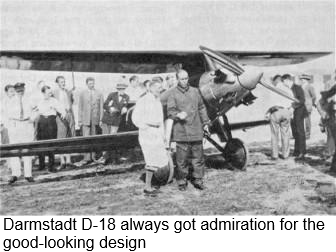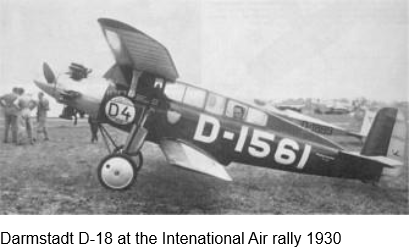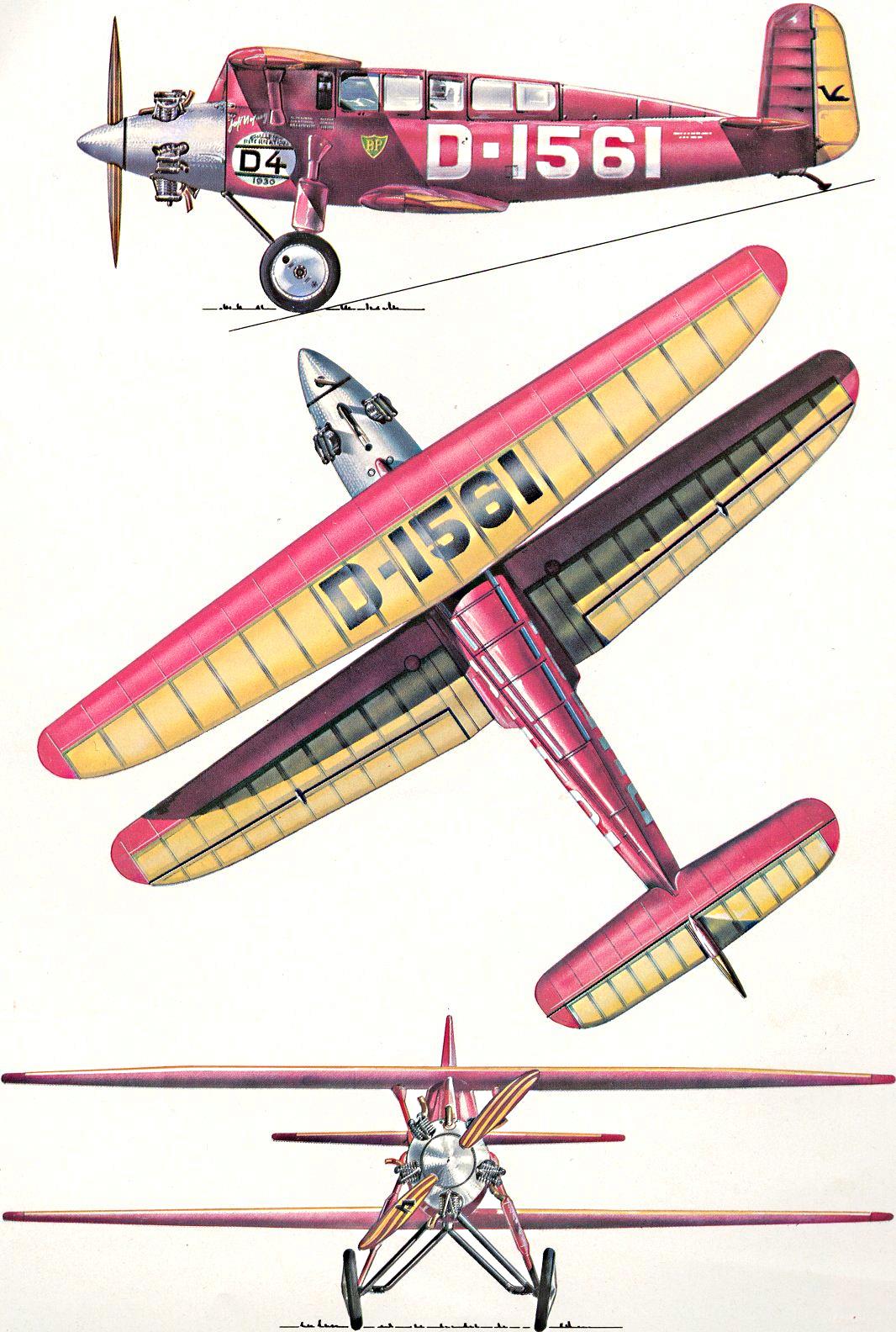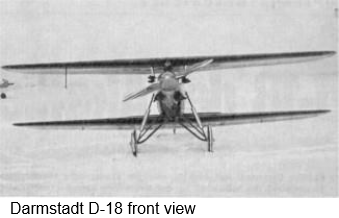| Type | Two seat sportplane | ||
| Engine | 1 Armstrong Genet 1 |
1 Armstrong Genet Major | |
| Dimensions | Length 6,14 m, height 2,62 m, span 7,20 m, wing area 12,1 m2, aspect ratio 4,3 | ||
| Weights | Empty 320 kg, fuel 70 kg, load 330 kg, loaded 650 kg, wing loading 53,7 kg/m2 | Empty 374 kg, fuel 70 kg, load 276 kg, loaded 650 kg, wing loading 53,7 kg/m2 | |
| Performance | Max. speed 200 km/h, climb to 1000 m 3,0 min., service ceiling 5800 m, range 800 km | Max. speed 196 km/h | |
| Type | Werk.Nr | Registration | History |
| D-1561 | Designed in 1929 by Dipl.Ing. F. Fecher with a wing profile designed by Joukovski. First flights were very promising. Transferred to Berlin for acceptance test by DVL (Pilots Nehring and Voight). Took part in the Europa-Rundflug 1929. The aircraft was flown 324.2 km with a fuel consumption of 27.95 kg with an average speed of 156.7 km/h. had to withdraw because of a crash. (Morzik won this competition with the Messerschmitt M-23). The aircraft was repaired, now with an Armstrong Genet Major engine. Now it set 3 world records : On the 21 of April 1930 Voight and Daulé reached 7521 m, on the 23 of April Rudolf Neininger and K. Stark flew from Darmstadt to Wiesbaden with a speed of 214,848 km/h, on the 23 of May 1930 Voight reached 8142 m. For the Europa-Rundflug 1930 it was equipped with an enclosed cockpit , encreased the weight to 374.3 kg. Engine problems forced Neininger to ditch in the Mediterranean, it was salvaged but was scrapped. |








The Akaflieg Darmstadt crew took part in the 1930 European flight with a cantilever biplane with a cabin structure. The aircraft was originally designed with open seats; it had a plywood-clad oval fuselage with four wooden spars as load-bearing elements. In a biplane, the both wings in such a way that the upper wing experiences a reduction in lift. The sum of the lifts of both wings is smaller than that of a monoplane with the same span and the same wing area. To compensate for this disadvantage, the wings of the biplane are staggered, which allows but also achieve better slow flight characteristics. If the wings are staggered forward, i.e. the upper wing is moved forward compared to the lower wing, the upper wing has a smaller setting and cast, which means that the flow on this wing breaks off first when the aircraft stalls. This makes the aircraft top-heavy and the flow attaches itself again.
With backward staggering, it is the other way round,
here the lower wing is set lower so that the flow on it breaks off first; this makes the aircraft top-heavy again and
the flow attaches itself again.
The D-18 had an extreme forward staggering and had fabric-covered wings. The upper wing was mounted on an aerodynamically covered tensioning bracket in the middle of the fuselage and
supported by a strut on each of the upper fuselage straps. The lower wing was fitted into the underside of the fuselage. The wheels of the main undercarriage were mounted on two three-strutted supports, with the upper strut providing the suspension.
A skid was installed in the rear.
The tail unit was covered with fabric and consisted of a narrow horizontal stabilizer with a two-part rudder attached to the top of the fuselage
and a narrow, high vertical stabilizer.
The D-18 was powered by an air-cooled 5-cylinder radial engine with 90 hp. The propeller hub and engine were covered in a streamlined shape, but the cylinders were exposed to free air flow.
With backward staggering, it is the other way round,
here the lower wing is set lower so that the flow on it breaks off first; this makes the aircraft top-heavy again and
the flow attaches itself again.
The D-18 had an extreme forward staggering and had fabric-covered wings. The upper wing was mounted on an aerodynamically covered tensioning bracket in the middle of the fuselage and
supported by a strut on each of the upper fuselage straps. The lower wing was fitted into the underside of the fuselage. The wheels of the main undercarriage were mounted on two three-strutted supports, with the upper strut providing the suspension.
A skid was installed in the rear.
The tail unit was covered with fabric and consisted of a narrow horizontal stabilizer with a two-part rudder attached to the top of the fuselage
and a narrow, high vertical stabilizer.
The D-18 was powered by an air-cooled 5-cylinder radial engine with 90 hp. The propeller hub and engine were covered in a streamlined shape, but the cylinders were exposed to free air flow.







